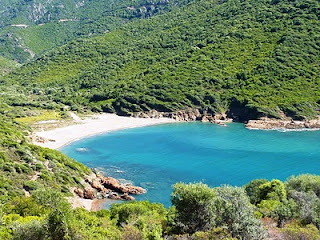La Scandola Nature Reserve Sept 20
Reserve Naturelle de Scandola, the result of ancient volcanic eruptions, is Corsica’s only Unesco-protected marine reserve. Here, you’ll find red granite cliffs plunge into the crystalline sea, where birds such as the cormorants, ospreys, kestrels, Audouin’s gull and the peregrine falcons seek shelter and food. The pure water also favours underwater life and species such as groupers and sea breams are found bountiful. Local fishermen have agreed not to work the waters off here. Look closely, and to your delight, sponges, yellow anemones, sea urchins and corals can be seen on water’s surface. This 9.2 sq km of land, runs between Punta Mucchilina and Punta Palazzo, is nature lovers’ paradise. It’s definitely worth a trip to explore.
Finally, weather forecasted light wind after 2 days of blow, gusting between 20 to 30 knots at times, and after a 5-day stay at Calvi, we’re anxious to get going. It didn’t happen vey often, but the forecast was inaccurate --- instead of light wind, we’re met with gusts over 25 knots and a confused sea with occasion swells as high as 3 meters. The hope of slowly motoring to enjoy the view of the nature reserve was blown off. However, it was not all lost, we saw some incredible landscapes and what Corsica was famous for – les calanques. Calanques are narrow, steep-sided valleys partially flooded by the sea, surrounded by rugged cliffs. Appropriately, calanca is a Corsican word, meaning “inlet”. One of these exotic Mediterranean fjords can be seen at Marina d’Elbo, where a ravine runs down into the sea to form a spectacular calanque. And less than a mile away, a narrow channel with a least depth of 3M between Punta Palazzo and Ile de Gargalu, is formed by red rock cliffs on either side and turquoise water under the keel.
To quote the Pilot Guide: “To those who are not familiar with the western side of Corsica, the mountains provide one of the most impressive backdrops to a coast in the western Mediterranean . In places, the mountains are the coast, where the mountains drop straight down into the sea and at times, this can cause a few problems for the yachtsman with confused swell up to a mile offshore. Winds are channeled through mountain gaps and funneled off the high slopes causing severe gusts in places. The weather and the sea are, like the land, savage and severe, and merit considerable respect.”
After six hours sailing with the katabatic wind, and so, with much respect, we had decided to call it a day and take up a mooring ball at Port Girolata, a sheltered cove around Cap Rossu with a Genoese tower on its summit. We had a restful night.
Next morning, after routine boat maintenance, we went on shore to explore this scenic part of the coast. At 10am, many tripper boats with happy holiday-makers had already set foot on shore. Not sure how much quality time was allotted, probably enough for them to get some food and back on the boats again. There’re two hiking trails and we went for the more scenic one as suggested by the Capitanaria staff.
After an hour and a half, the trail ended at Plage de Tuara. The trail was not difficult, but it would be ideal if equipped with hiking stick(s) as certain areas were steep with loose gravels and uneven rocks. There are many look-out points along the way overlooking the village, the bay and beyond. We didn’t see too many animals, but we did see one cow! At first, on one of the points, and eventually, made it down to the meadow by the beach.
Corsica is an interesting island and the locals are proud of their land. We will miss Corsica, an island with diverse contrasts in scenery and landscapes, but we are also looking forward to our next destination, the French Riviera, and to meet up with our oldest daughter, where she will be our tour guide to show us the place she lived and the places she enjoyed.








No comments:
Post a Comment